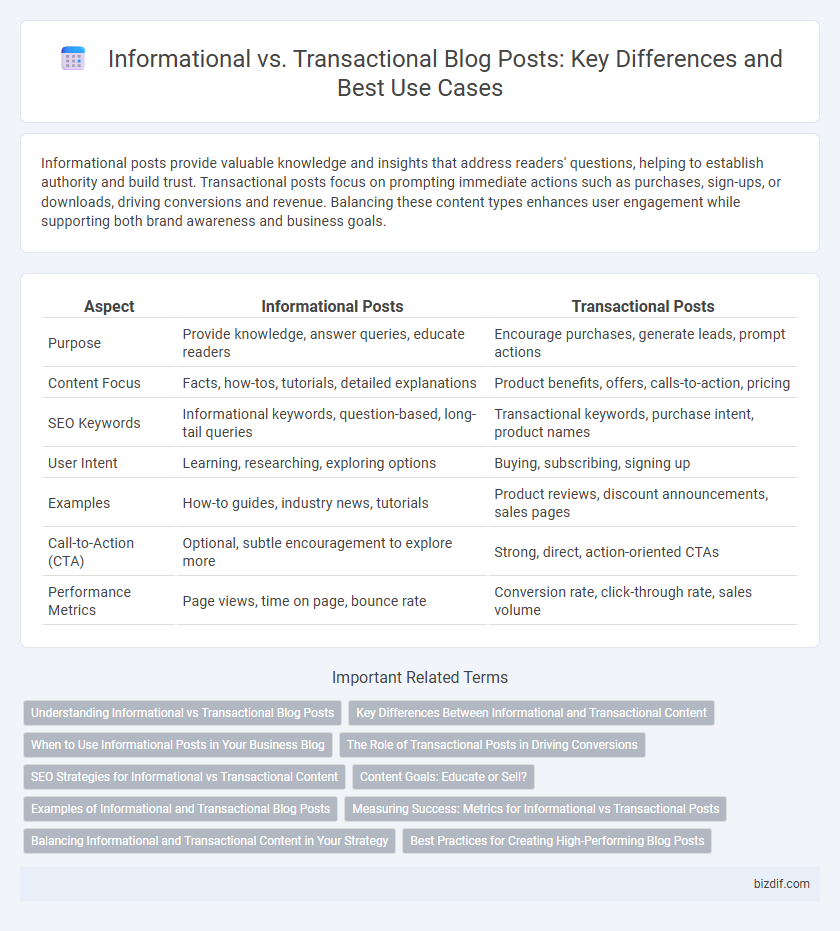Informational posts provide valuable knowledge and insights that address readers' questions, helping to establish authority and build trust. Transactional posts focus on prompting immediate actions such as purchases, sign-ups, or downloads, driving conversions and revenue. Balancing these content types enhances user engagement while supporting both brand awareness and business goals.
Table of Comparison
| Aspect | Informational Posts | Transactional Posts |
|---|---|---|
| Purpose | Provide knowledge, answer queries, educate readers | Encourage purchases, generate leads, prompt actions |
| Content Focus | Facts, how-tos, tutorials, detailed explanations | Product benefits, offers, calls-to-action, pricing |
| SEO Keywords | Informational keywords, question-based, long-tail queries | Transactional keywords, purchase intent, product names |
| User Intent | Learning, researching, exploring options | Buying, subscribing, signing up |
| Examples | How-to guides, industry news, tutorials | Product reviews, discount announcements, sales pages |
| Call-to-Action (CTA) | Optional, subtle encouragement to explore more | Strong, direct, action-oriented CTAs |
| Performance Metrics | Page views, time on page, bounce rate | Conversion rate, click-through rate, sales volume |
Understanding Informational vs Transactional Blog Posts
Informational blog posts provide valuable insights, answer common questions, and educate readers about a specific topic, boosting organic traffic through relevant content. Transactional blog posts focus on encouraging readers to take action, such as making a purchase, signing up for a service, or downloading a resource, driving conversions and sales. Understanding the difference helps bloggers strategically balance content to both attract and engage their target audience effectively.
Key Differences Between Informational and Transactional Content
Informational posts primarily aim to educate the audience by providing valuable insights, how-to guides, or industry knowledge that addresses specific questions or problems. Transactional posts focus on driving immediate actions such as purchases, sign-ups, or downloads, often featuring clear calls-to-action and product or service highlights. The key difference lies in their purpose: informational content nurtures trust and engagement, while transactional content targets conversions and sales.
When to Use Informational Posts in Your Business Blog
Informational posts are essential for building trust and authority by providing valuable insights, answering common questions, and addressing customer pain points within your industry. These posts are most effective when your audience is in the research or awareness stage of the buyer's journey, seeking knowledge before making a purchasing decision. Prioritize informational content to educate readers, improve SEO rankings, and cultivate long-term engagement with potential customers.
The Role of Transactional Posts in Driving Conversions
Transactional posts play a crucial role in driving conversions by directly targeting users with purchasing intent through clear calls to action, product reviews, and special offers. These posts are crafted to guide readers towards completing a transaction, often incorporating detailed product information, comparisons, and promotional content that addresses buyer needs. Optimizing transactional posts with relevant keywords, compelling content, and user-friendly design significantly increases conversion rates and revenue generation on blogging platforms.
SEO Strategies for Informational vs Transactional Content
Optimizing SEO strategies for informational posts involves targeting long-tail keywords and providing comprehensive, authoritative content that answers user queries and improves dwell time. Transactional posts prioritize conversion-focused keywords and clear calls to action, encouraging immediate user engagement such as purchases or sign-ups. Leveraging analytics to differentiate intent-driven content ensures higher relevance, improved search rankings, and increased ROI for both informational and transactional posts.
Content Goals: Educate or Sell?
Informational posts prioritize educating readers by providing valuable insights, how-to guides, and detailed explanations that build trust and authority. Transactional posts are designed to drive sales by focusing on product features, benefits, and clear calls-to-action that encourage immediate purchases. Effective content strategies balance these goals to attract, engage, and convert audiences at different stages of the buyer's journey.
Examples of Informational and Transactional Blog Posts
Informational blog posts include how-to guides, tutorials, and industry news that educate readers without prompting immediate purchases, such as "10 Steps to Improve Your SEO Strategy" or "Understanding Blockchain Technology." Transactional blog posts focus on driving conversions by highlighting product features, reviews, or special offers, like "Top 5 Laptops Under $1000 for Students" or "Why Our Project Management Software Boosts Team Productivity." Both types serve unique purposes: informational posts build trust and authority, while transactional posts encourage sales and lead generation.
Measuring Success: Metrics for Informational vs Transactional Posts
Measuring success for informational posts centers on metrics like average time on page, bounce rate, and social shares, indicating how effectively content educates and engages readers. Transactional posts prioritize conversion rate, click-through rate (CTR), and revenue generated to assess their impact on driving sales or actions. Analyzing these distinct metrics enables marketers to optimize content strategy according to specific goals, whether building brand authority or boosting immediate transactions.
Balancing Informational and Transactional Content in Your Strategy
Balancing informational and transactional posts in your blogging strategy enhances user engagement and drives conversions by addressing both audience education and buying intent. Informational content provides valuable knowledge and builds trust, while transactional posts encourage actions like purchases or sign-ups. An effective mix ensures sustained traffic growth and improved SEO performance through diverse keyword targeting.
Best Practices for Creating High-Performing Blog Posts
Informational posts should prioritize clear, comprehensive content that educates readers and answers common questions, leveraging keyword research to enhance SEO and user engagement. Transactional posts must focus on persuasive calls-to-action, concise product or service descriptions, and trusted reviews to boost conversion rates. Utilizing data-driven insights and incorporating multimedia elements improve readability and maintain audience retention across both post types.
Informational posts vs Transactional posts Infographic

 bizdif.com
bizdif.com